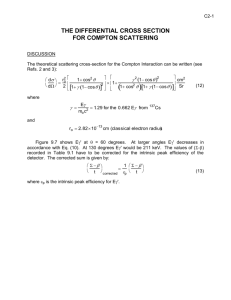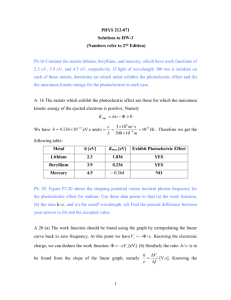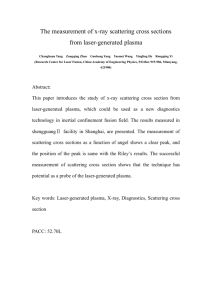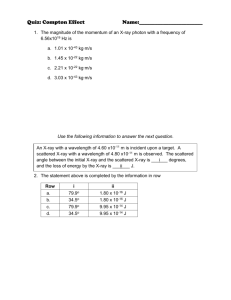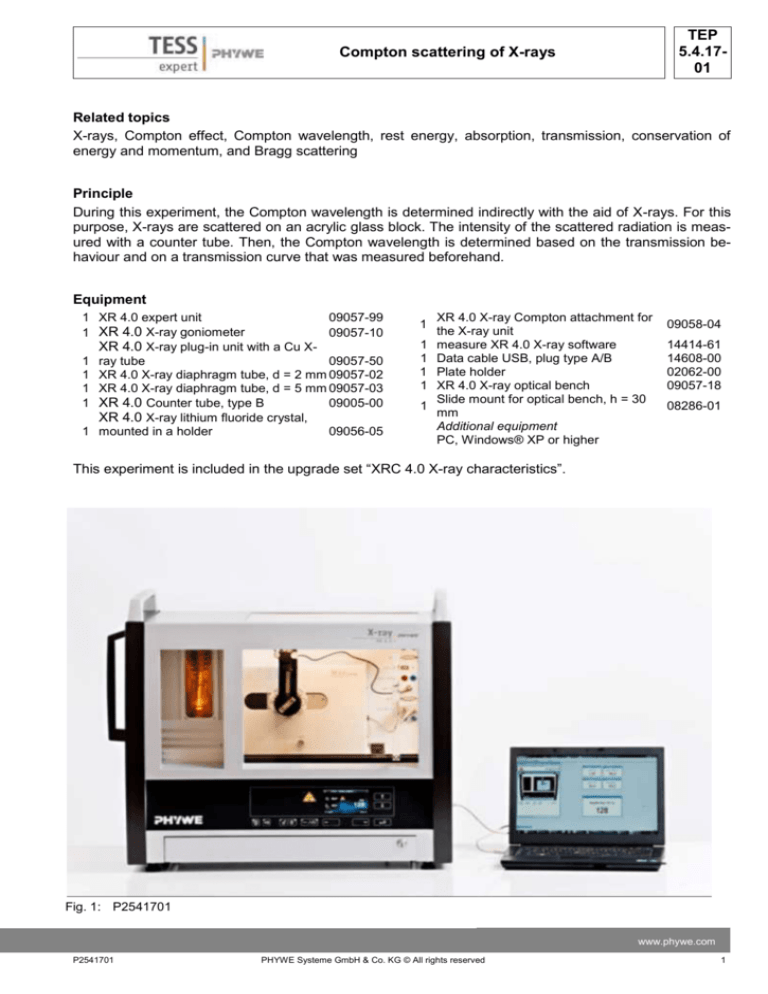
TEP
5.4.1701
Compton scattering of X-rays
Related topics
X-rays, Compton effect, Compton wavelength, rest energy, absorption, transmission, conservation of
energy and momentum, and Bragg scattering
Principle
During this experiment, the Compton wavelength is determined indirectly with the aid of X-rays. For this
purpose, X-rays are scattered on an acrylic glass block. The intensity of the scattered radiation is measured with a counter tube. Then, the Compton wavelength is determined based on the transmission behaviour and on a transmission curve that was measured beforehand.
Equipment
1 XR 4.0 expert unit
09057-99
1 XR 4.0 X-ray goniometer
09057-10
XR 4.0 X-ray plug-in unit with a Cu X1 ray tube
09057-50
1 XR 4.0 X-ray diaphragm tube, d = 2 mm 09057-02
1 XR 4.0 X-ray diaphragm tube, d = 5 mm 09057-03
1 XR 4.0 Counter tube, type B
09005-00
XR 4.0 X-ray lithium fluoride crystal,
1 mounted in a holder
09056-05
1
1
1
1
1
1
XR 4.0 X-ray Compton attachment for
the X-ray unit
measure XR 4.0 X-ray software
Data cable USB, plug type A/B
Plate holder
XR 4.0 X-ray optical bench
Slide mount for optical bench, h = 30
mm
Additional equipment
PC, Windows® XP or higher
09058-04
14414-61
14608-00
02062-00
09057-18
08286-01
This experiment is included in the upgrade set “XRC 4.0 X-ray characteristics”.
Fig. 1: P2541701
www.phywe.com
P2541701
PHYWE Systeme GmbH & Co. KG © All rights reserved
1
TEP
5.4.1701
Compton scattering of X-rays
Tasks
1. Determine the transmission of an aluminium absorber as a function of the Bragg angle and plot
it as a function of the wavelength of the radiation.
2. Measure the intensity of the radiation that is
scattered at an angle of a) 60° b) 90° and c)
120° on an acrylic glass block with and without
an absorber.
3. Determine the Compton wavelength of the electron based on the transmission curve.
Set-up
Connect the goniometer and the Geiger-Müller
counter tube to their respective sockets in the experiment chamber (see the red markings in Fig 2).
The goniometer block with the analyser crystal Fig. 2: Connectors in the experiment chamber
should be located in a position in the middle. Fasten
the Geiger-Müller counter tube with its holder to the
back stop of the guide rails. Do not forget to install
the diaphragm in front of the counter tube.
Insert a diaphragm tube with a diameter of 2 mm
into the beam outlet of the tube plug-in unit for the
collimation of the X-ray beam.
For calibration: Make sure, that the correct crystal is entered in the goniometer parameters. Then,
select “Menu”, “Goniometer”, “Autocalibration”.
The device now determines the optimal positions
of the crystal and the goniometer to each other Fig. 3: Connection of the computer
and then the positions of the peaks.
Note
Details concerning the operation of the X-ray unit
and goniometer as well as information on how to
handle the monocrystals can be found in the respective operating instructions.
Procedure
- Connect the X-ray unit via the USB cable to the
USB port of your computer (the correct port of
the X-ray unit is marked in Fig. 3).
- Start the “measure” program. A virtual X-ray unit
will be displayed on the screen.
- You can control the X-ray unit by clicking the
various features on and under the virtual X-ray
unit. Alternatively, you can also change the parameters at the real X-ray unit. The program will
automatically adopt the settings.
2
For setting the
X-ray tube
For setting the
goniometer
Fig. 4: Part of the user interface of the software
PHYWE Systeme GmbH & Co. KG © All rights reserved
P2541701
Compton scattering of X-rays
Fig. 5: Settings of the goniometer, task 1
-
-
TEP
5.4.1701
Fig. 6: Voltage and current settings
If you click the experiment chamber (see the red marking in Figure 4), you can change the parameters of the experiments. Select the parameters for task 1 as shown in Figure 5.
If you click the X-ray tube (see the red marking in Figure 5), you can change the voltage and current
of the X-ray tube. Select the parameters as shown in Figure 6.
-
Start the measurement by clicking the red circle.
-
After the measurement, the following window appears:
-
Select the first item and confirm by clicking OK. The measured values will now be transferred directly
to the “measure” software.
Task 1: Determination of the transmission of aluminium
Use the analyser crystal lithium fluoride and insert a diaphragm tube with a diameter of 2 mm into the
beam outlet of the tube plug-in unit for the collimation of the X-ray beam
Settings: See Overview
Determine the pulse rate n1(ϑ) of the X-rays reflected by the crystal in angle steps of 0.1° between the glancing angle ϑ = (5.5–9.5)°, by
means of synchronized rotation of the crystal and
the counter tube in the angular relationship 2:1.
Use a measuring time of 100 s.
Repeat the measurement after you have positioned the aluminium absorber in front of the out-
Overview of the settings of the goniometer
and X-ray unit for task 1:
- 2:1 coupling mode
- Gate time 100 s (gate timer); angle step
width 0.1°
- Scanning range 5.5° < ϑ < 9.5°
-
Anode voltage UA = 35 kV; anode current
IA = 1 mA
www.phywe.com
P2541701
PHYWE Systeme GmbH & Co. KG © All rights reserved
3
TEP
5.4.1701
Compton scattering of X-rays
let of the X-ray plug-in unit using the plate holder
mounted in the slide mount on the optical bench to
measure the pulse rate n2(ϑ).
In order to keep the relative error of n as small as
possible, high rates are necessary.
At high pulse rates, however, the dead time τ of the
counter tube must be taken into consideration since
the counter tube does not register all of the incident
photons (see theory and evaluation).
Task 2: Determination of the Compton scattering
Remove the analyser crystal and replace it with the
acrylic glass scatterer. Position this at an angle of
10° (see Figs. 7 and 8). Replace the diaphragm
tube with an aperture of d = 2 mm with the one with
an aperture of d = 5 mm. Turn the counter tube to
a) 60°, b) 90°, c) 120°.
Measure the pulse rates using the following set- Fig. 7: Schematic representation of the 90° Compton
ups:
scattering arrangement.
N3: with the acrylic glass scatterer but without the
aluminium absorber
N4: with the acrylic glass scatterer and with the aluminium absorber in position 1 (use the plate holder
to fix it).
N5: with the acrylic glass scatterer and with the aluminium absorber in position 2.
For the measurement of N4, position the aluminium
absorber between the diaphragm and the scatterer
(use the plate holder to fix it). For the measurement
of N5, the aluminium absorber is fastened to the
Geiger-Müller counter tube by pushing it into the diaphragm that is installed in front of the counter
tube.
For every set-up, note down three measurement
values. The measuring time is 100 seconds.
At very low pulse rates, it may be necessary to take
the background radiation into consideration at UA =
0 V.
Theory
The absorption of a material is determined by three
different interaction processes. Their relative contributions depend on the atomic number (nuclear
charge number) Z and on the mass number A of the
shielding material.
The most important individual processes are:
Photoelectric effect; attenuation ~ Z4/A
4
Fig. 8: Set-up for task 2. Position of the scatterer and GM
counter tube for 90°-scattering. Absorber in position
1.
PHYWE Systeme GmbH & Co. KG © All rights reserved
P2541701
TEP
5.4.1701
Compton scattering of X-rays
Compton scattering; attenuation ~ Z/A
Pair generation; attenuation ~ Z2/A.
As a result, the energy-dependent absorption coefficient of a material μ consists of the absorption
coefficient of the pair generation μPa, of the photoelectric effect μPh, and of the Compton effect μCo.
Two additional mechanisms, the nuclear photoelectric effect and the normal elastic scattering, can
usually be neglected for the screening effect.
-
μ = μPa+μPh+μCo
For the X-radiation range that we focus on (E ≈ 1100 keV), μPa can be neglected (see Fig. 9). μPh is
also not relevant for this experiment since only
electrons, and not photons, are released. As a re- Fig. 9: Absorption coefficient as a function of the energy
sult, the detector detects nearly exclusively Compin the case of aluminium
ton fractions.
A schematic representation of the Compton effect
is shown in Fig. 10. Due to the interaction with a
free electron in the solid material, the incident photon loses energy and is scattered from its original
direction under the scattering angle ϑ. The electron
that was previously at rest absorbs additional kinetic energy and leaves the collision point under the
angle φ.
Based on the principle of conservation of energy
and momentum, the energy of the scattered photon Fig. 10: Momentum and energy relationships in Compton scattering
is obtained as a function of the scattering angle
(see the appendix):
E2
E1
E
1 1 2 1 cos
m0 c
(1)
Photon energy before or after the collision E1 or E2
Scattering angle
ϑ
c = 2.998∙108 ms-1
m0 = 9.109∙10-31 kg
Speed of light in vacuum
Rest mass of the electron
After the collision, the photon has a smaller energy E2 and, therefore, a greater wavelength λ2 than before the collision. With E = hν, (1) can be converted into:
1
h 2
1
1
1 cos
h 1 m0 c 2
(2)
Planck’s constant
h = 6.626∙10-34 Js
Photon frequency ν
With λ = c/ν, equation (2) leads to:
www.phywe.com
P2541701
PHYWE Systeme GmbH & Co. KG © All rights reserved
5
TEP
5.4.1701
Compton scattering of X-rays
2 1
h
1 cos
m0 c
(3)
For 90°-scattering, the wavelength difference, which consists only of the three universal components,
leads to the so-called Compton wavelength λC for electrons.
C
h
6,626 10 34
Js
2,426 pm
31
8
m0 c 9,109 10 2,998 10 kg ms 1
For the special cases of backward scatter (ϑ = 180°), the change in wavelength is Δλ = 2λC.
Evaluation
Task 1: Determine the transmission of an aluminium absorber as a function of the Bragg angle and plot it
as a function of the wavelength of the radiation.
Based on the glancing angles ϑ as well as on the Bragg relationship, the associated wavelengths λ are
obtained:
2d sin n
(4)
with d = 201.4 pm = LiF-(200) interplanar spacing and here: n = 1.
For a given gate time Δt and the pulse rate n the total number of incidents N is n·Δt.
For the measured number of incidents N, the relative error of N is given by the ratio:
N
N
1
N
N
N
(5)
At high pulse rates, the dead time τ of the counter tube must also be taken into consideration, since it
does not register all of the incident photons. For the GM counter tube that is used in this experiment, it is
90 ns.
The true pulse rate n* can be obtained from the measured pulse rate n with the aid of:
n*
n
1 n
(6)
Correct the measured count rate in an angle range of 5.5° < ϑ < 9.5° and with the dead time τ = 90 μs of
the Geiger-Müller counter tube. This can be done using the software measure:
Select “analysis”, then “X-ray spectroscopy” and “dead time correction”. Now you can either create a
new measurement with the corrected data or add the corrected graph into the old measurement.
The true pulse rates are then used to determine the transmission curve
𝑇(𝜆) =
𝑛2∗ (𝑤𝑖𝑡ℎ 𝑎𝑛 𝑎𝑏𝑠𝑜𝑟𝑏𝑒𝑟)
𝑛1∗ (𝑤𝑖𝑡ℎ𝑜𝑢𝑡 𝑎𝑛 𝑎𝑏𝑠𝑜𝑟𝑏𝑒𝑟
It is then plotted as a function of λ (see Fig. 11).
Task 2 and 3: Measure the intensity of the radiation that is scattered at an angle of 60°, 90° and 120° on
an acrylic glass block with and without an absorber and determine the Compton wavelength of the electron based on the transmission curve.
In this experiment, the aluminium absorber acts as a kind of strong colour filter. It absorbs shorter wavelengths less strongly than longer wavelengths. This means that if it is positioned in front of the scatterer,
it has a different effect than in the long-wave scattered radiation behind the scatterer. This enables the
6
PHYWE Systeme GmbH & Co. KG © All rights reserved
P2541701
TEP
5.4.1701
Compton scattering of X-rays
determination of the wavelength of the scattered and non-scattered radiation.
By placing the absorber in the ray path between the X-ray tube and the scatterer (position 1, Fig. 8), you
0.8
0.7
0.6
y = -0,018x + 1,3928
T(λ)
0.5
0.4
0.3
0.2
0.1
0
33
43
53
λ in pm
63
73
Fig. 11: Transmission curve of aluminium in a narrow wavelength range
can determine the transmission T1 = n4/n3 of the still non-scattered X-radiation. When the absorber is in
position 2, you obtain the transmission of the scattered X-radiation.
Since we have determined the dependence of the transmission of aluminium on the wavelength in task
1, we can now directly infer from the transmission to the wavelength of the X-radiation that passes
through the absorber. The two different transmission coefficients that are obtained from the 90° scattering (T1 > T2) then lead to the corresponding wavelengths.
Sample results
Fig. 11 shows transmission curve of aluminium in a narrow wavelength range including the equation of
the regression line:
y = -0.018x + 1.3928
The results from Task 2 for n3*, n4* and n5* are listed in table 1
Sample calculation for the 90° scattering:
T1
N *4 n *4 t 83.625 Imp / s
0.347 1.27% ;
N *3 n *3 t 241.121 Imp / s
T2
N *5
76.017 Imp/s
0.315 1.32% ;
N *3 241.121 Imp/s
The deviation of ±1.27% and ±1.32% is calculated with the aid of equation (2) and the following equation
(use the total number of incidents N* = n*·Δt for the calculation):
www.phywe.com
P2541701
PHYWE Systeme GmbH & Co. KG © All rights reserved
7
TEP
5.4.1701
Compton scattering of X-rays
1
T1
N *
4
2
2
1
N * 3
The relative error only takes into account the statistical errors. Systematic errors (see note) are not considered.
Based on the linear equation of the regression line in Fig. 11, the associated wavelengths for the 90°
scattering result as 58.93 pm and 61.48 pm. This results in a wavelength difference of Δλ = λC = 2.56 pm,
which is very close to the theoretical value of λC = 2.426 pm.
Table 1 sample results
ϑ
n3*
60°
241.121
90°
178.833
120°
216.124
n4*
83.625
59.315
70.444
n5*
76.017
51.235
58.81
T1
0.347
0.332
0.336
T2
0.315
0.286
0.272
λ1
λ2
Δλ
58.09
58.93
58.71
59.87
61.48
62.26
1.78
2.56
3.56
The experiment show that with decreasing scattering angle, the difference in wavelength also decreases.
Note
There is a systematic error, since
o X-rays are also diffracted at the aluminium sheet so that they might actually enter the
counter directly.
o The incident x-radiation is polychromatic
o The geometry of the scattering region is not spherical
-
8
The error caused by fluorescence is negligible because the corresponding radiation energy is too
low to be registered.
PHYWE Systeme GmbH & Co. KG © All rights reserved
P2541701


